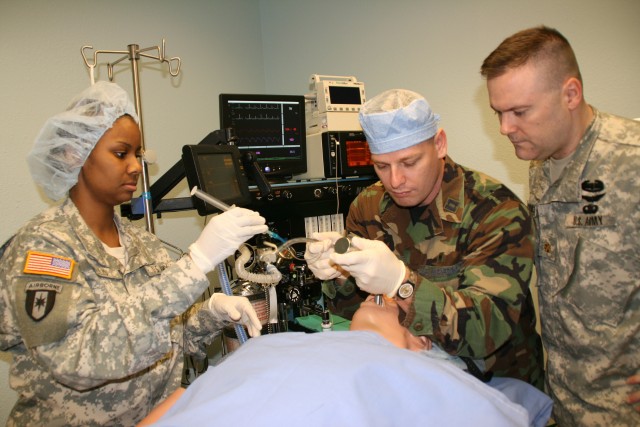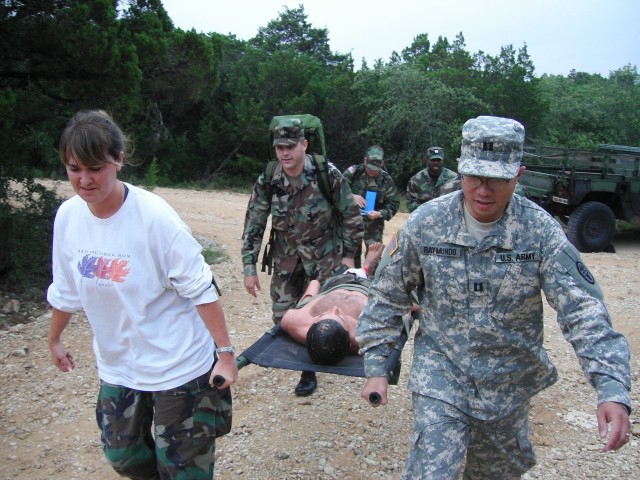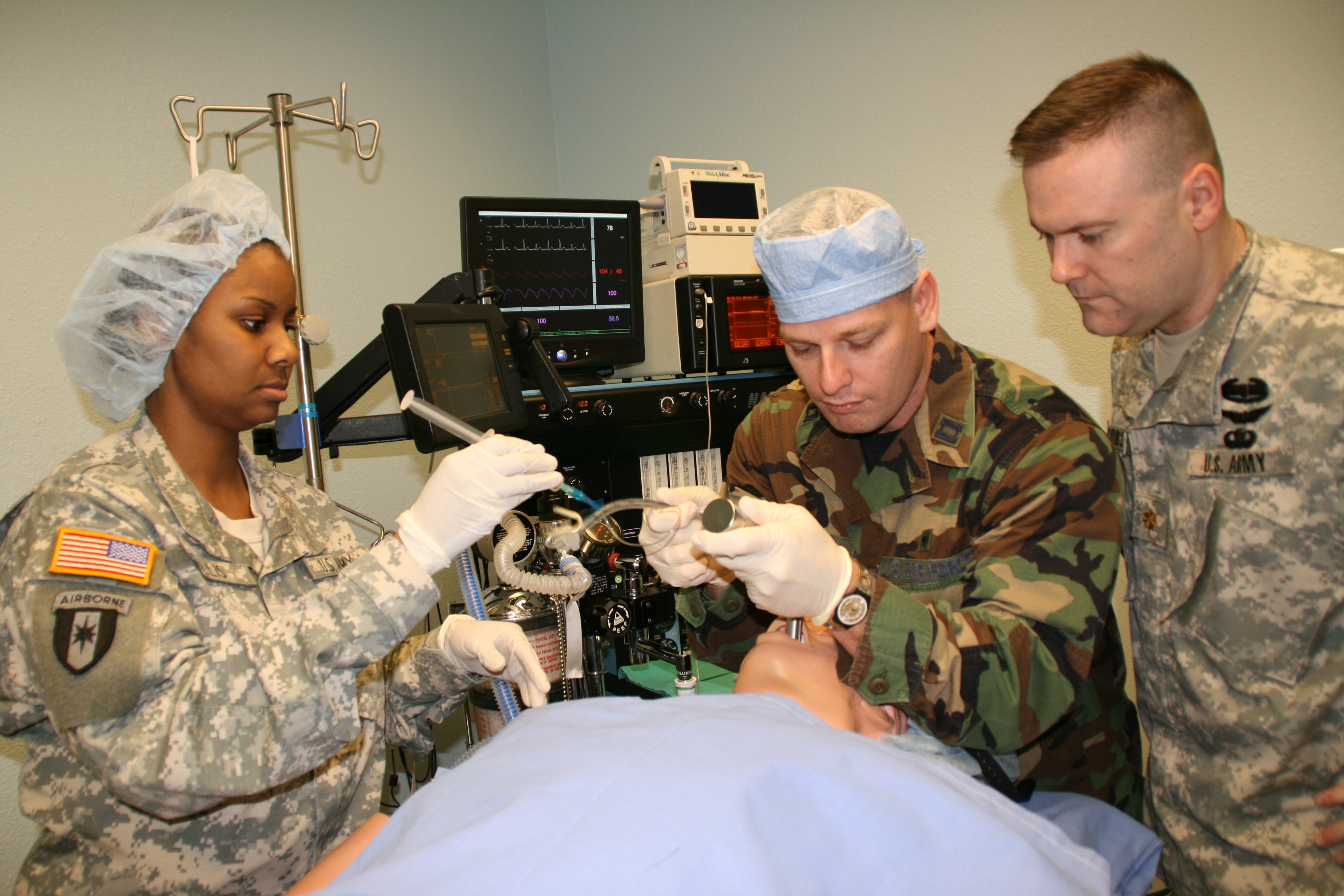FORT SAM HOUSTON, Texas (Army News Service, April 12, 2007) - An Army Medical Department Center and School program was ranked second in the nation by the U.S. News and World Report magazine in this year's edition of "America's Best Graduate Schools," which hit the stands in early April.
The U.S. Army Graduate Program in Anesthesia Nursing missed top spot in the Nursing-Anesthesia category by only a tenth of a point with a score of 4.0 out of 5.0. Virginia Commonwealth University earned a score of 4.1.
"We're inching our way up to a top ranking," said Lt. Col. Thomas Ceremuga, anesthesia nursing program director, referring to the increase in the program's score. The program was last ranked in 2003, when it earned second place with a score of 3.8.
The U.S. News and World Report bases its nurse specialty rankings on ratings by educators and deans at peer schools, according to the magazine.
With 106 nursing anesthesia schools in the nation, Lt. Col. Ceremuga said the high regard is a valuable compliment, although he is quick to attribute the program's success to the quality and dedication of the faculty and students. "I'm very appreciative for all the hard work within the school, and the esteem our peers have for us in the nursing community."
The Army program at Fort Sam Houston produces more than 90 percent of the Army's certified registered nurse anesthetists, as well as Air Force and Veterans Administration CRNAs. With the CRNA career field in high demand, Lt. Col. Ceremuga said he works to ensure the competitive program fully equips the nurses for peacetime and war.
"Most of our CRNAs will deploy soon after they graduate so we need to ensure they receive the training they need for a deployment as we teach them the basic skills they need to be a certified registered nurse anesthetist," Lt. Col. Ceremuga said.
The anesthesia nursing program comprises a year of classroom training and another 18 months of clinical training at one of several Phase 2 sites, located in military hospitals and medical centers throughout the nation. Classes average about 40 people and are open to Army, Air Force and VA registered nurses. The students are required to have a bachelor's degree in nursing science and a year or two of nursing experience under their belts to compete for a seat in the class.
"It's competitive," Lt. Col. Ceremuga said. "We have some students with five to 10 years of experience here earning their second master's degree. The students are very accomplished overall."
With an average attrition rate of 25 percent, the experience level and maturity of a slightly older student body comes in handy although "the attrition rate due to academics is not as high as the number reflects," Lt. Col. Ceremuga explained. "About half of the students in that percentage leave for personal reasons as opposed to academic."
During a rigorous training schedule, students learn to administer anesthesia in a variety of settings, from an operating room in a stateside hospital to a forward surgical team downrange. Training encompasses a variety of anesthesia agents and the administration of local, regional and general anesthesia.
Additionally, during a short break from classroom sessions, students take on a scientific research project while in Phase 1, then write up and present findings at local and national conferences during Phase 2. A recent research study examined the effectiveness of the blankets the Army uses to prevent hypothermia, and another looked at the effect herbs have on emergence from anesthesia.
The positive exposure from public appearances only helps to improve the school's reputation, said Dr. Don Johnson, research program director. "Our students are at the forefront. They represent the school very well."
Like the students, instructors also are experienced, with Army, Air Force and VA backgrounds. One of the instructors, Dr. Doug Christi, was recently named the AMEDDC&S' instructor of the year.
Program leaders and instructors have strived to keep the training current, particularly when applying lessons learned from the field. A recent data call helped tailor the course to today's needs.
"We queried Army and Air Force nurse anesthetists who have deployed and have shifted our focus so our training reflects current events," Lt. Col. Ceremuga said, adding that there is now more of a training emphasis on trauma rotations, central line placement, pediatric care, emergency airway management, regional anesthesia and pain management.
At the completion of training, students receive a master's degree from a partnering university, which offers administrative support and issues the master's degrees. Up until now, students received the degree from the University of Texas at Houston Health and Science Center. However, starting with the next class in June, a new contract has partnered the Army with Northeastern University in Boston.
Upon graduation, students become mostly autonomous, an aspect of the career field that is attractive to many of the nurses, who would otherwise be required to have oversight from a doctor in many other settings.
"A nurse anesthetist is the culmination of critical care and independence," said Capt. Thurayya Gillis, head nurse of same-day surgery and pre-op at Fort Jackson, S.C. "You can provide the care rather than just deliver it."
With its highly reputable program, the Army has no problem attracting trainees. Notable graduates include the acting Army Surgeon General Maj. Gen. Gale Pollock and retired Brig. Gen. William Bester, acting dean of nursing at Uniformed Services University of the Health Sciences. But with salaries running into six figures for nurse anesthetists outside the military, the Army does have trouble retaining trained CRNAs.
"It's hard to compete with the salaries in the civilian sector," Lt. Col. Ceremuga said. "All we have is our name, our reputation and a promise of a high-quality education.
"The students who apply and come to this program know they can make more elsewhere. They know they will have to deploy," he said. "That tells me something about their character and their patriotism."
The new class in June will have 52 students, a record number for the program and a testament to the program's high-quality education. However, Maj. Jeffrey Conroy, Lt. Col. Ceremuga's right hand and the director of the simulation program, said the appeal of the Army program is not based on rankings alone.
"We may not have been ranked No. 1, but we've always had the No. 1 mission - taking care of Soldiers," he said.
(Ms. Elaine Wilson writes for the Fort Sam Houston Public Information Office.)






Social Sharing